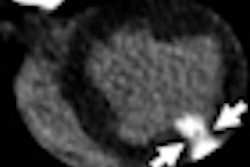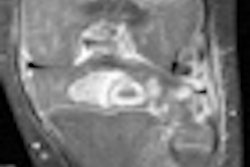People who suspect that men's and women's hearts march to different drummers now have proof from cardiac MRI. Myocardial motion is strongly influenced by gender as well as age, according to researchers from Freiburg, Germany.
"[Left ventricular (LV)] function is one of the most prognostic determinants of cardiac diseases, and an exact analysis of myocardial performance is crucial for patients with heart disease," wrote Daniela Föll and colleagues from University Hospital Freiburg in Circulation: Cardiovascular Imaging.
The study is among the first to provide gender- and age-specific data on the motions of the normal heart based on a regional analysis of myocardial velocities covering 16 segments of the left ventricle, the authors wrote in the study published online December 8.
The results, obtained with MRI tissue-phase mapping (TPM), provide the most precise measurements yet of the left ventricle's complex motions as it contracts and relaxes with each heartbeat.
TPM provides a comprehensive quantitative analysis of all myocardial velocities with high temporal and spatial resolution," Föll and colleagues wrote. "The knowledge of the detected age- and gender-related differences in myocardial motion is fundamental for further investigations of cardiac disease."
The investigators used TPM to analyze segmental, 3D myocardial velocities with high temporal resolution (13.8 msec) to assess left ventricular motion.
The heart performs a complex wringing motion with each beat, and the base of the left ventricle changes its rotational direction up to six times per beat, the authors explained. Meanwhile, the ventricle's top rotates counterclockwise during contraction and clockwise during relaxation.
The researchers aimed to evaluate myocardial motion segmentally to define age- and gender-based influences on LV performance in 58 healthy volunteers (29 men, 29 women). The subjects were divided into three age groups:
- Group 1: 20 to 40 years (n = 19, 10 men)
- Group 2: > 40 to 60 years (n = 20, 9 men)
- Group 3: > 60 years (n = 19, 10 men)
Electrocardiogram-gated and respiration-controlled images were acquired on a 1.5-tesla MRI scanner (Magnetom Sonata, Siemens Healthcare, Malvern, PA) using a black-blood k-space segmented gradient-echo sequence (temporal resolution = 6.9 msec, flip angle = 15°, bandwidth = 650 Hz per pixel) with a spatial resolution of 1.3 x 1.3 mm. Data were acquired in basal, midventricular, and apical short-axis planes, with a slice thickness of 8 mm and temporal resolution of 13.8 msec.
The results showed that age and gender strongly influence regional motion of the heart muscle during both relaxation and contraction. Contrary to previous studies, the authors found that apex rotation speed decreased with increasing age.
For increased age, reduced and prolonged long-axis and radial velocities during diastole and reduced long-axis velocities and apical rotation during systole were found for both genders, they wrote.
Among younger participants, women had higher up-and-down motion velocities along the long axis of the ventricle than men. According to the measurements, women showed reduced systolic twist (p = 0.009), reduced apical rotation (p = 0.01), and reduced systolic radial velocities compared to men.
However, these motion-speed differences were reversed in older volunteers. A segmental analysis of long-axis motion with aging revealed a regional reduction of systolic (lateral 52% versus 30%) velocities in women compared to men.
Women also had reduced twisting of the ventricle, apex rotation, and lower muscle velocity toward the left ventricular center during contraction compared to men. In addition, the age-related changes in peak motion speeds persisted after the team accounted for differences in left ventricle shape and blood pressure.
Over time, MRI showed greater declines in women than men in muscle shortening and expansion from the ventricle's base to its top during both contraction and relaxation, Föll and colleagues wrote, adding that age-related changes in peak motion speeds persisted even after adjusting for differences in left ventricle shape and blood pressure.
According to measurements in the basal segments, younger women had 11% higher long-axis velocities than men, but these differences were reversed in older subjects by 20% in the same segments.
"We were surprised by the differences of myocardial motion we found in women, which were not all explained by anatomical differences," Föll said.
Previous studies have mainly used tissue Doppler ultrasound imaging to evaluate myocardial velocities, the group noted. And although echo tissue Doppler velocity analysis of myocardial motion with strain and strain rate imaging have been shown to be useful tools, the methods are limited by operator dependency and the acoustic window of the patient.
Echo is therefore limited in that it cannot assess all myocardial velocity components, i.e., radial, longitudinal, and circumferential motion, and the LV regions, while TPM has been previously validated and shown to demonstrate low inter- and intraobserver variabilities.
The main limitation of the present study is that it lacks measurement of pathologically altered LV performance.
"Age and gender strongly influence regional myocardial motion," the authors concluded. "TPM provides a comprehensive quantitative analysis of all myocardial velocities with high temporal and spatial resolution."
The extensive differences seen in myocardial performance with aging in relation to gender "form an essential base for further patient studies and may help to further elucidate the complexity of the performance of the heart muscle," they wrote.
By Eric Barnes
AuntMinnie.com staff writer
December 18, 2009
Related Reading
Echocardiography test beats SPECT for predicting problems after MI, December 7, 2009
Echo plus ECG team up to find heart flaws in athletes, November 16, 2009
Tissue Doppler beats standard echo in predicting heart failure, April 11, 2008
Echo functionality grows with processing power, August 31, 2006
MRI phase-mapping quantifies regional wall motion, April 3, 2006
Copyright © 2009 AuntMinnie.com



.fFmgij6Hin.png?auto=compress%2Cformat&fit=crop&h=100&q=70&w=100)




.fFmgij6Hin.png?auto=compress%2Cformat&fit=crop&h=167&q=70&w=250)











